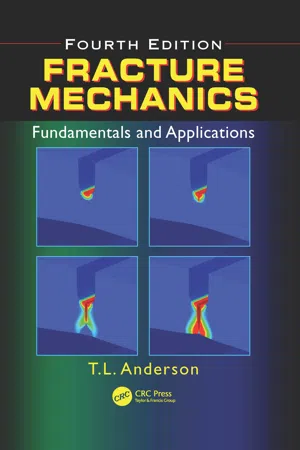7
Fracture Toughness Testing of Metals
A fracture toughness test measures the resistance of a material to crack extension. Such a test may yield either a single value of fracture toughness or a resistance curve, where a toughness parameter such as K, J, or CTOD is plotted against crack extension. A single toughness value is usually sufficient to describe a test that fails by cleavage, because this fracture mechanism is typically unstable. The situation is similar to the schematic in Figure 2.10a, which illustrates a material with a flat R curve. Cleavage fracture actually has a falling resistance curve, as Figure 4.8 illustrates. Crack growth by microvoid coalescence, however, usually yields a rising R curve, such as that shown in Figure 2.10b; ductile crack growth can be stable, at least initially. When ductile crack growth initiates in a test specimen, that specimen seldom fails immediately. Therefore, one can quantify ductile fracture resistance either by the initiation value or by the entire R curve.
A variety of organizations throughout the world publish standardized procedures for fracture toughness measurements, including the American Society for Testing and Materials (ASTM), the British Standards Institution (BSI), the International Organization for Standardization (ISO), and the Japan Society for Mechanical Engineers (JSME). The first standards for K and J testing were developed by ASTM in 1970 and 1981, respectively, while BSI published the first CTOD test method in 1979.
Existing fracture toughness standards include procedures for KIc, K–R curve, JIc, J–R curve, CTOD, and KIa testing. This chapter focuses primarily on ASTM standards, since they are most widely used throughout the world. Standards produced by other organizations, however, are broadly consistent with the ASTM procedures, and usually differ only in minute details. The existing standards are continually evolving, as the technology improves and more experience is gained.
The reader should not rely on this chapter alone for guidance on conducting fracture toughness tests, but should consult the relevant standards. Moreover, the reader is strongly encouraged to review Chapters 2 and 3 in order to gain an understanding of the fundamental basis of K, J, and CTOD, as well as the limitations of these parameters.
7.1 General Considerations
The majority of fracture toughness tests have several common features. The design of test specimens is similar in most of the standards, and the orientation of the specimen relative to symmetry directions in the material is always an important consideration. The cracks in test specimens are introduced by fatigue in each case, although the requirements for fatigue loads vary from one standard to the next. The basic instrumentation required to measure load and displacement is common to most fracture mechanics tests, but some tests require additional instrumentation to monitor crack growth.
7.1.1 Specimen Configurations
Fracture experiments can be grouped into two categories: material tests and component tests. Most standardized fracture toughness tests fall into the former category. Full-scale tests of structural components are less common and usually do not follow a standard procedure. Section 7.9 describes two simplified component tests that have recently been standardized. The discussion that follows is restricted to tests whose intention is to measure the fracture characteristics of the material of interest.
There are five types of specimens that are permitted in ASTM standards that characterize fracture initiation and crack growth, although no single standard allows all five configurations, and the design of a particular specimen type may vary between standards. The configurations that are currently standardized include the compact tension (C(T)) specimen, the single-edge notched bend (SE(B)) geometry, the arc-shaped specimen, the disk specimen, and the middle tension (MT) panel. Figure 7.1 shows a drawing of each specimen type.
Each specimen configuration has three important characteristic dimensions: the crack length (a), the thickness (B), and the width (W). In most cases, W = 2B and a/W ≈ 0.5, but there are exceptions which are discussed later in this chapter.
The vast majority of fracture toughness tests are performed on either C(T) or SE(B) specimens. Figure 7.2 illustrates the profiles of these two specime...
